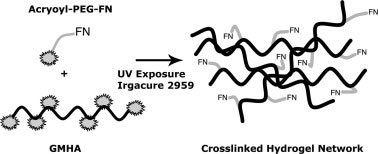Acta Biomaterialia, 2011, 7:2401-2409.
Fibronectin-Hyaluronic Acid Composite Hydrogels for Three-Dimensional Endothelial Cell Culture
Stephanie K. Seidlitsa, Charles T. Drinnana, Rebecca R. Petersena, Jason B. Shearb, Laura J. Suggsa and Christine E. Schmidt
Biomaterials that actively promote both wound healing and angiogenesis are of critical importance for many biomedical applications, including tissue engineering. In particular, hyaluronic acid (HA) is an important player that has multiple roles throughout the angiogenic process in the body. Previously, our laboratory has developed photocrosslinkable HA-based scaffolds that promote angiogenesis when implanted in vivo. This paper reports the incorporation of a photocrosslinkable fibronectin (FN) conjugate into three-dimensional (3-D) HA hydrogel networks to enhance endothelial cell adhesion and angiogenesis. The results demonstrate significantly better retention of FN that was photocrosslinked within HA hydrogels compared to FN that was physically adsorbed within HA hydrogels. Increased viability of endothelial cells cultured in 3-D HA hydrogels with photoimmobilized FN, compared to adsorbed FN, was also observed. Endothelial cells were cultured within hydrogels for up to 6 days, a period over which cell proliferation, migration and an angiogenic phenotype were influenced by varying the concentration of incorporated FN. The results demonstrate the potential of these composite hydrogels as biomaterial scaffolds capable of promoting wound healing and angiogenesis.
Keywords: Hyaluronic acid; Fibronectin; Endothelial cells; Angiogenesis; Hydrogels

Permanent Link:doi:10.1016/j.actbio.2011.03.024
